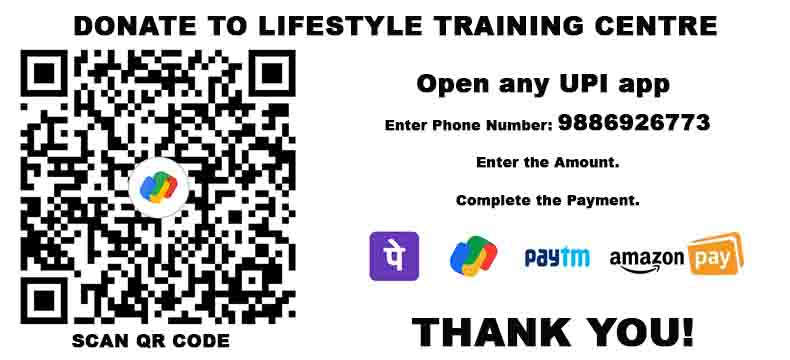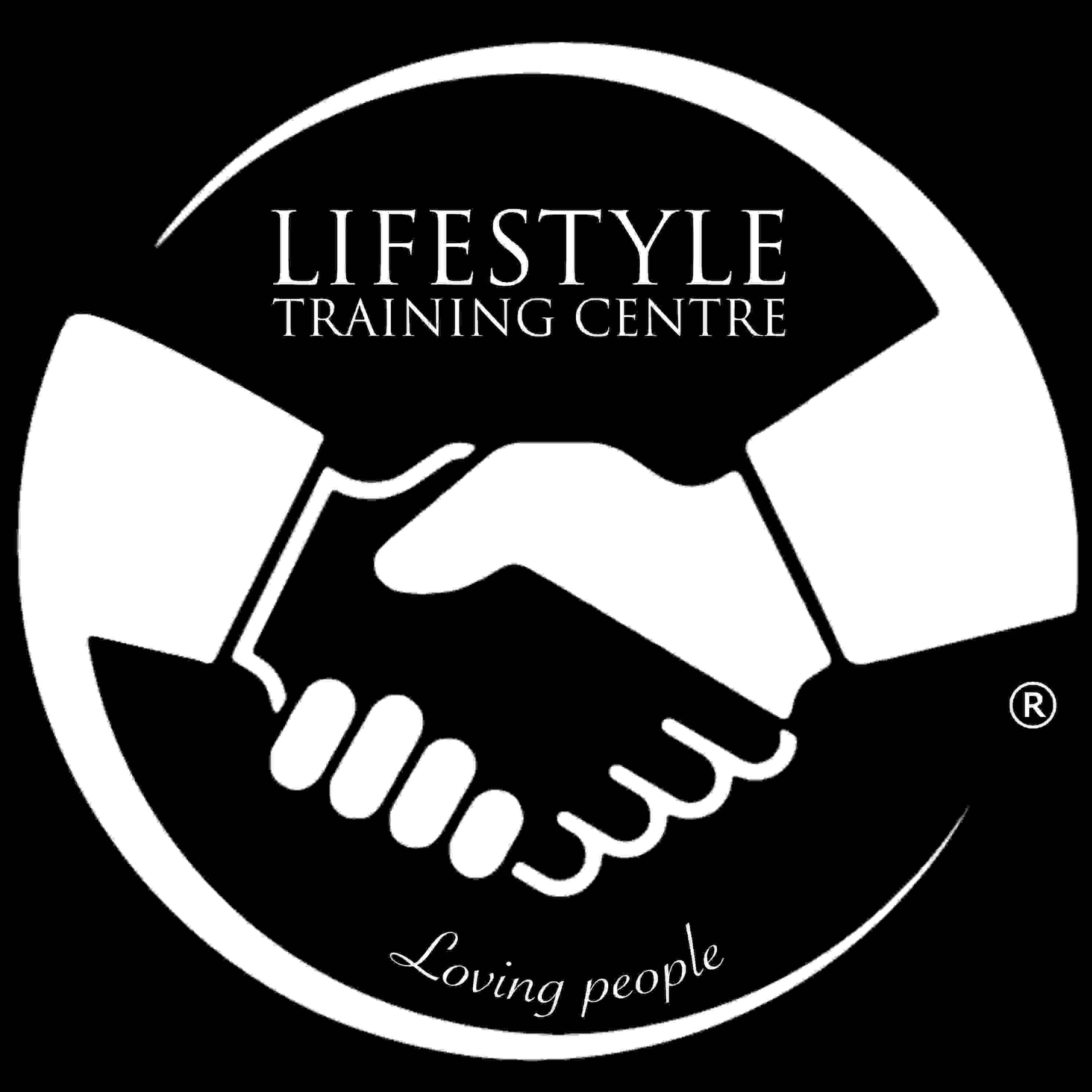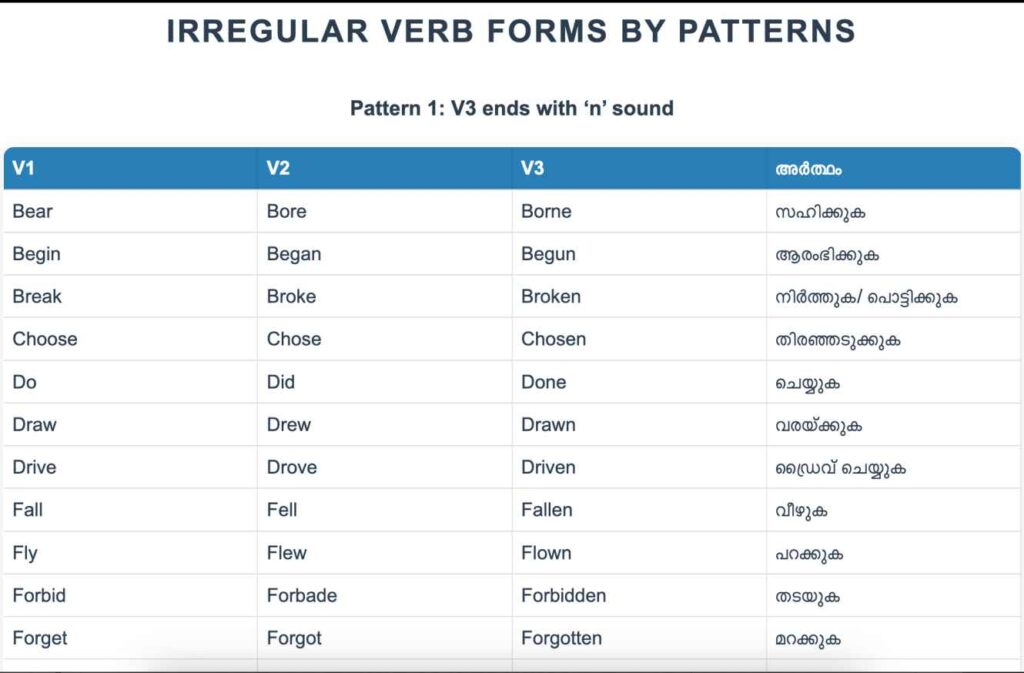Verb and their forms
Imagine a world without action—no movement, no speech, no thoughts. It would be lifeless. Verbs are the heartbeat of a language; they bring words to life by expressing actions, states, and occurrences. Whether you’re running in a race, thinking about the future, or being happy, verbs make communication possible.
In English, verbs change their forms to indicate time (tense), aspect, and voice. Mastering these verb forms is crucial for fluency. They are categorised into regular and irregular verbs. Let’s explore them in detail!
Irregular Verbs – Learn with 5 Patterns
Unlike regular verbs, irregular verbs do not follow a consistent pattern. Their past simple (V2) and past participle (V3) forms change unpredictably. However, you don’t need to memorise them randomly! Instead, you can learn them by recognising 5 different sound patterns: ✅
Irregular Verb Forms by Patterns
Click on any word for pronunciation Pattern 1: V3 ends with ‘n’ sound
| V1 | V2 | V3 | അർത്ഥം |
|---|---|---|---|
| Bear | Bore | Borne | സഹിക്കുക |
| Begin | Began | Begun | ആരംഭിക്കുക |
| Break | Broke | Broken | നിർത്തുക/ പൊട്ടിക്കുക |
| Choose | Chose | Chosen | തിരഞ്ഞടുക്കുക |
| Do | Did | Done | ചെയ്യുക |
| Draw | Drew | Drawn | വരയ്ക്കുക |
| Drive | Drove | Driven | ഡ്രൈവ് ചെയ്യുക |
| Fall | Fell | Fallen | വീഴുക |
| Fly | Flew | Flown | പറക്കുക |
| Forbid | Forbade | Forbidden | തടയുക |
| Forget | Forgot | Forgotten | മറക്കുക |
| Forgive | Forgave | Forgiven | ക്ഷമിക്കുക |
| Freeze | Froze | Frozen | ശീതീകരിക്കുക/ മരവിപ്പിക്കുക |
| Get | Got | Gotten/Got | നേടുക |
| Give | Gave | Given | നൽകുക |
| Go | Went | Gone | പോകുക |
| Grow | Grew | Grown | വളരുക |
| Know | Knew | Known | അറിയുക |
| Lie | Lay | Lain | കിടക്കുക, കള്ളം പറയുക |
| Ride | Rode | Ridden | ഓടിക്കുക |
| Rise | Rose | Risen | ഊർജ്ജം ഉയർത്തുക |
| See | Saw | Seen | കാണുക |
| Shake | Shook | Shaken | കുലുക്കുക |
| Bite | Bit | Bitten | കടിക്കുക |
| Speak | Spoke | Spoken | പറയുക |
| Stride | Strode | Stridden | വേഗത്തിൽ നടക്കുക |
| Swear | Swore | Sworn | സത്യം ചെയ്യുക, ചീത്ത വിളിക്കുക |
| Take | Took | Taken | എടുക്കുക |
| Throw | Threw | Thrown | എറിയുക |
| Wake | Woke | Woken | ഉണരുക |
| Wear | Wore | Worn | ധരിക്കുക |
| Withdraw | Withdrew | Withdrawn | പിന്മാറുക |
| V1 | V2 | V3 | അർത്ഥം |
|---|---|---|---|
| Drink | Drank | Drunk | കുടിക്കുക |
| Ring | Rang | Rung | ബെൽ അടിക്കുക |
| Shrink | Shrank | Shrunk | ചുരുക്കുക |
| Sing | Sang | Sung | പാടുക |
| Sink | Sank | Sunk | മുങ്ങുക |
| Sling | Slang | Slung | ചുഴറ്റുക, വലിച്ചു കെട്ടുക |
| Spring | Sprang | Sprung | പോട്ടിമുളക്കുക, കുതിക്കുക |
| Stink | Stank | Stunk | നാറുക |
| String | Strung | Strung | വരിഞ്ഞു മുറുക്കുക |
| Swing | Swung | Swung | പലചരിയിൽ ചലിക്കുക |
| Wring | Wrung | Wrung | പിഴിയുക |
| Fling | Flung | Flung | വലിച്ചെറിയുക |
| Hang | Hung | Hung | തൂക്കിയിടുക |
| Cling | Clung | Clung | പറ്റിപ്പിടിക്കുക |
| Slink | Slunk | Slunk | കാണപ്പെടാതെ ഒഴിഞ്ഞുമാറുക |
| Stick | Stuck | Stuck | ഒട്ടിക്കുക |
| V1 | V2 | V3 | അർത്ഥം |
|---|---|---|---|
| Bid | Bid | Bid | വില പറയുക (ലേലത്തിൽ) |
| Broadcast | Broadcast | Broadcast | പ്രസിദ്ധീകരിക്കുക |
| Burst | Burst | Burst | പൊട്ടുക |
| Cast | Cast | Cast | വലിച്ചെറിയുക, ചലച്ചിത്ര വേഷം നൽകുക |
| Cost | Cost | Cost | ചെലവാകുക |
| Cut | Cut | Cut | മുറിക്കുക |
| Fit | Fit | Fit | അനുയോജ്യമാകുക |
| Hit | Hit | Hit | അടിക്കുക |
| Hurt | Hurt | Hurt | പരുക്കേൽപ്പിക്കുക |
| Knit | Knit | Knit | നെയ്യുക |
| Let | Let | Let | അനുമതി കൊടുക്കുക |
| Put | Put | Put | വെയ്ക്കുക |
| Quit | Quit | Quit | നിർത്തുക |
| Read | Read | Read | വായിക്കുക |
| Set | Set | Set | സജ്ജീകരിക്കുക |
| Shed | Shed | Shed | തളിക്കുക, കൊഴിക്കുക |
| Shut | Shut | Shut | അടയ്ക്കുക |
| Slit | Slit | Slit | പിളര്ക്കുക, ചീന്തുക |
| Split | Split | Split | വിച്ഛേദിക്കുക |
| Spread | Spread | Spread | വ്യാപിക്കുക, പരത്തുക |
| Thrust | Thrust | Thrust | ബലത്തിൽ തള്ളുക, കുത്തികയറ്റുക |
| Wet | Wet | Wet | നനയ്ക്കുക |
| V1 | V2 | V3 | അർത്ഥം |
|---|---|---|---|
| Bend | Bent | Bent | വളയ്ക്കുക |
| Lend | Lent | Lent | കടം കൊടുക്കുക |
| Rend | Rent | Rent | പിളർത്തുക, കീറുക |
| Spend | Spent | Spent | ചെലവഴിക്കുക |
| Blend | Blent | Blent | കൂട്ടിക്കലർത്തുക |
| Send | Sent | Sent | അയയ്ക്കുക |
| Build | Built | Built | നിർമിക്കുക |
| V1 | V2 | V3 | അർത്ഥം |
|---|---|---|---|
| Buy | Bought | Bought | വാങ്ങുക |
| Bring | Brought | Brought | കൊണ്ടുവരിക |
| Seek | Sought | Sought | അന്വേഷിക്കുക |
| Teach | Taught | Taught | പഠിപ്പിക്കുക |
| Think | Thought | Thought | ചിന്തിക്കുക |
| Catch | Caught | Caught | പിടിക്കുക |
| Keep | Kept | Kept | നിലനിറുത്തുക, സൂക്ഷിക്കുക |
| Leave | Left | Left | വിടവാങ്ങുക |
| Feel | Felt | Felt | അനുഭവിക്കുക |
| Light | Lit | Lit | പ്രകാശം കൊടുക്കുക, കത്തിക്കുക |
| Build | Built | Built | നിർമിക്കുക |
| Fight | Fought | Fought | പോരാടുക |
| Sleep | Slept | Slept | ഉറങ്ങുക |
Regular Verb Forms
Click on any word for pronunciation REGULAR VERBS – end with “ed”
| V1 | V2 | V3 | അർത്ഥം |
|---|---|---|---|
| Accept | Accepted | Accepted | സ്വീകരിക്കുക |
| Ask | Asked | Asked | ചോദിക്കുക |
| Bake | Baked | Baked | അപ്പം ചുടുക |
| Call | Called | Called | വിളിക്കുക |
| Dance | Danced | Danced | നൃത്തം ചെയ്യുക |
| End | Ended | Ended | അവസാനിപ്പിക്കുക |
| Finish | Finished | Finished | പൂർത്തിയാക്കുക |
| Guess | Guessed | Guessed | അനുമാനിക്കുക |
| Help | Helped | Helped | സഹായിക്കുക |
| Jump | Jumped | Jumped | ചാടുക |
| Kiss | Kissed | Kissed | ചുംബിക്കുക |
| Laugh | Laughed | Laughed | ചിരിക്കുക |
| Move | Moved | Moved | നീങ്ങുക |
| Need | Needed | Needed | ആവശ്യമാകുക |
| Open | Opened | Opened | തുറക്കുക |
| Paint | Painted | Painted | ചായം പൂശുക |
| Play | Played | Played | കളിക്കുക |
| Reach | Reached | Reached | എത്തുക |
| Study | Studied | Studied | പഠിക്കുക |
| Talk | Talked | Talked | സംസാരിക്കുക |
| Use | Used | Used | ഉപയോഗിക്കുക |
| Walk | Walked | Walked | നടക്കുക |
| Watch | Watched | Watched | കാണുക |
| Work | Worked | Worked | ജോലിചെയ്യുക |
Verb: Bear
V1 (Base): Bear
V2 (Past): Bore
V3 (Past Participle): Borne
Example: The mother bear bore her cubs into the den.
Some regular verb forms are supposed to be pronounced differently – Watch this video:
Would you like to download a copy of the irregular verb forms? Please click on the download button below:

What is a Verb?
A verb is a word that expresses:
- Action → “She writes a letter.”
- State of being → “He is tired.”
- Occurrence → “A storm developed suddenly.”
Verbs are dynamic and adapt to different grammatical situations through four main forms:
- Base Form (V1) – The simplest form (e.g., go, eat, write)
- Past Simple (V2) – Used for completed actions (e.g., went, ate, wrote)
- Past Participle (V3) – Used in perfect tenses and passive voice (e.g., gone, eaten, written)
- Present Participle (V4) – The “-ing” form used in continuous tenses (e.g., going, eating, writing)
Let’s explore each verb form in detail with examples.
1. Base Form (V1) – The Root of Action
The base form of a verb is its simplest form, free from tense or conjugation. It is used in:
✅ Present Simple (except third-person singular)
- “I run every morning.”
- “They speak three languages.”
✅ Infinitive (with “to”)
- “I love to read books.”
- “She wants to travel the world.”
✅ Commands (Imperatives)
- “Sit down!”
- “Open the door.”
🚀 Examples of Base Forms:
go, eat, write, play, think, dance, sing, sleep, jump, watch
2. Past simple form (V2) – Expressing Completed Actions
The past simple form shows actions that happened in the past and are finished.
✅ Regular verbs add “-ed” or “-d”:
- “She worked late last night.”
- “They danced at the party.”
✅ Irregular verbs change completely:
- “He went to school early.” (go → went)
- “I wrote a poem.” (write → wrote)
🔎 Usage Examples:
- “We watched a movie yesterday.” (Regular)
- “She ate an apple for breakfast.” (Irregular)
🚀 Examples of Past Simple Forms:
went, ate, wrote, played, thought, danced, sang, slept, jumped, watched
3. Past Participle (V3) – The Key to Perfect Tenses
The past participle is used in:
✅ Perfect tenses (with has/have/had)
- “She has finished her homework.”
- “We had eaten before they arrived.”
✅ Passive voice (with “be”)
- “The letter was written by John.”
- “A new law has been passed.”
🔎 Regular verbs → same as past simple (played, walked)
🔎 Irregular verbs → unique changes (gone, eaten, written)
🚀 Examples of Past Participles:
gone, eaten, written, played, thought, danced, sung, slept, jumped, watched
4. Present Participle (V4) – The Continuous Action
The present participle is the “-ing” form of a verb. It is used in:
✅ Continuous tenses (with is/am/are/was/were)
- “She is reading a book.”
- “They were playing football.”
✅ Gerunds (verbs acting as nouns)
- “Swimming is my favourite sport.”
- “Reading helps improve vocabulary.”
🚀 Examples of Present Participles:
going, eating, writing, playing, thinking, dancing, singing, sleeping, jumping, watching
Comparison of Verb Forms
| Base Form (V1) | Past Simple (V2) | Past Participle (V3) | Present Participle (V4) |
|---|---|---|---|
| Go | Went | Gone | Going |
| Eat | Ate | Eaten | Eating |
| Write | Wrote | Written | Writing |
| Play | Played | Played | Playing |
| Think | Thought | Thought | Thinking |
| Dance | Danced | Danced | Dancing |
| Sing | Sang | Sung | Singing |
Regular and Irregular Verbs – A Complete Guide
What Are Regular and Irregular Verbs?
In English, verbs are divided into regular and irregular categories based on how they change in the past simple (V2) and past participle (V3) forms.
1. Regular Verbs
Regular verbs follow a consistent pattern when forming the past simple and past participle. They simply add “-ed” or “-d” to the base form (V1).
✅ Examples:
- Walk → Walked → Walked
- Play → Played → Played
- Talk → Talked → Talked
2. Irregular Verbs
Irregular verbs do not follow a fixed pattern. Their past simple and past participle forms change in unpredictable ways.
✅ Examples:
- Go → Went → Gone
- Eat → Ate → Eaten
- Write → Wrote → Written
Regular Verbs – Rules & Examples
Regular verbs follow three simple rules when forming their past tense:
Rule 1: Add “-ed” to most verbs
For most verbs, simply add “-ed” to form the past simple and past participle.
✅ Examples:
- Work → Worked → Worked
- Jump → Jumped → Jumped
- Call → Called → Called
Rule 2: If the verb ends in “e,” add only “-d”
If a verb already ends in “e,” just add “-d” instead of “-ed”.
✅ Examples:
- Live → Lived → Lived
- Love → Loved → Loved
- Change → Changed → Changed
Rule 3: If the verb ends in consonant + “y,” change “y” to “i” and add “-ed”
If a verb ends with a consonant + “y,” change “y” to “i” before adding “-ed”.
✅ Examples:
- Study → Studied → Studied
- Carry → Carried → Carried
- Cry → Cried → Cried
🚨 Exception: If the verb ends in a vowel + “y,” just add “-ed”:
- Play → Played → Played
- Enjoy → Enjoyed → Enjoyed
FAQ
1. What are the four verb forms in English?
✅ The four main verb forms are:
- V1 (Base Form): The original verb (e.g., go)
- V2 (Past Form): Simple past tense (e.g., went)
- V3 (Past Participle): Used in perfect tenses (e.g., gone)
- V4 (Present Participle): The -ing form (e.g., going)
2. Why are verb forms important in English?
✅ They are essential for forming correct tenses, including past, present, and future perfect tenses.
3. Can you give an example of all four verb forms?
✅ Example with the verb “Eat”:
- V1: Eat
- V2: Ate
- V3: Eaten
- V4: Eating
4. How can I memorise verb forms easily?
✅ Practice verb lists, use flashcards, and read sentences with different verb tenses to reinforce learning.
5. How can I learn all the verbs in the world?
To master all verb forms, start by learning the patterns shown on this page for V1, V2, V3, and V4. Observe how verbs follow consistent rules and apply the same logic to other verbs. Instead of memorizing each verb individually, focus on understanding the patterns and structures demonstrated in the table. This approach will make learning verb forms easier and more effective.
We hope this information has been valuable to you. If so, please consider a monetary donation to Lifestyle Training Centre via UPI. Your support is greatly appreciated.

Would you like to undergo training for OET, PTE, IELTS, Duolingo, Phonetics, or Spoken English with us? Kindly contact us now!
📱 Call/WhatsApp/Text: +91 9886926773
📧 Email: mail@goltc.in
Visit us in person by following the directions on Google Maps. We look forward to welcoming you to the Lifestyle Training Centre.
Follow Lifestyle Training Centre on social media:
Thank you very much!

